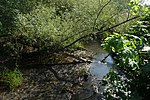Nicomen Island
1860s establishments in British ColumbiaFormer municipalities in British ColumbiaIslands of the Fraser RiverLandforms of Lower MainlandPopulated places in the Fraser Valley Regional District ... and 2 more
Populated places on the Fraser RiverUse Canadian English from January 2023
Nicomen Island is an island in the Fraser Valley region of southwestern British Columbia. Nicomen Mountain in the Douglas Ranges lies to the north across Nicomen Slough. Chilliwack Mountain lies to the south across the Fraser River. Adjacent to the northeast is Skumalasph Island. Dewdney, which by road is about 11 kilometres (7 mi) east of Mission, extends onto the northwestern end of the island. Deroche, which by road is about 29 kilometres (18 mi) west of Agassiz extends onto the northeastern end.
Excerpt from the Wikipedia article Nicomen Island (License: CC BY-SA 3.0, Authors).Nicomen Island
Nicomen Island Trunk Road, Area G (Deroche/Dewdney/Sumas Mountain)
Geographical coordinates (GPS) Address Nearby Places Show on map
Geographical coordinates (GPS)
| Latitude | Longitude |
|---|---|
| N 49.164444444444 ° | E -122.11666666667 ° |
Address
Nicomen Island Trunk Road
Nicomen Island Trunk Road
V2P 7X3 Area G (Deroche/Dewdney/Sumas Mountain)
British Columbia, Canada
Open on Google Maps


